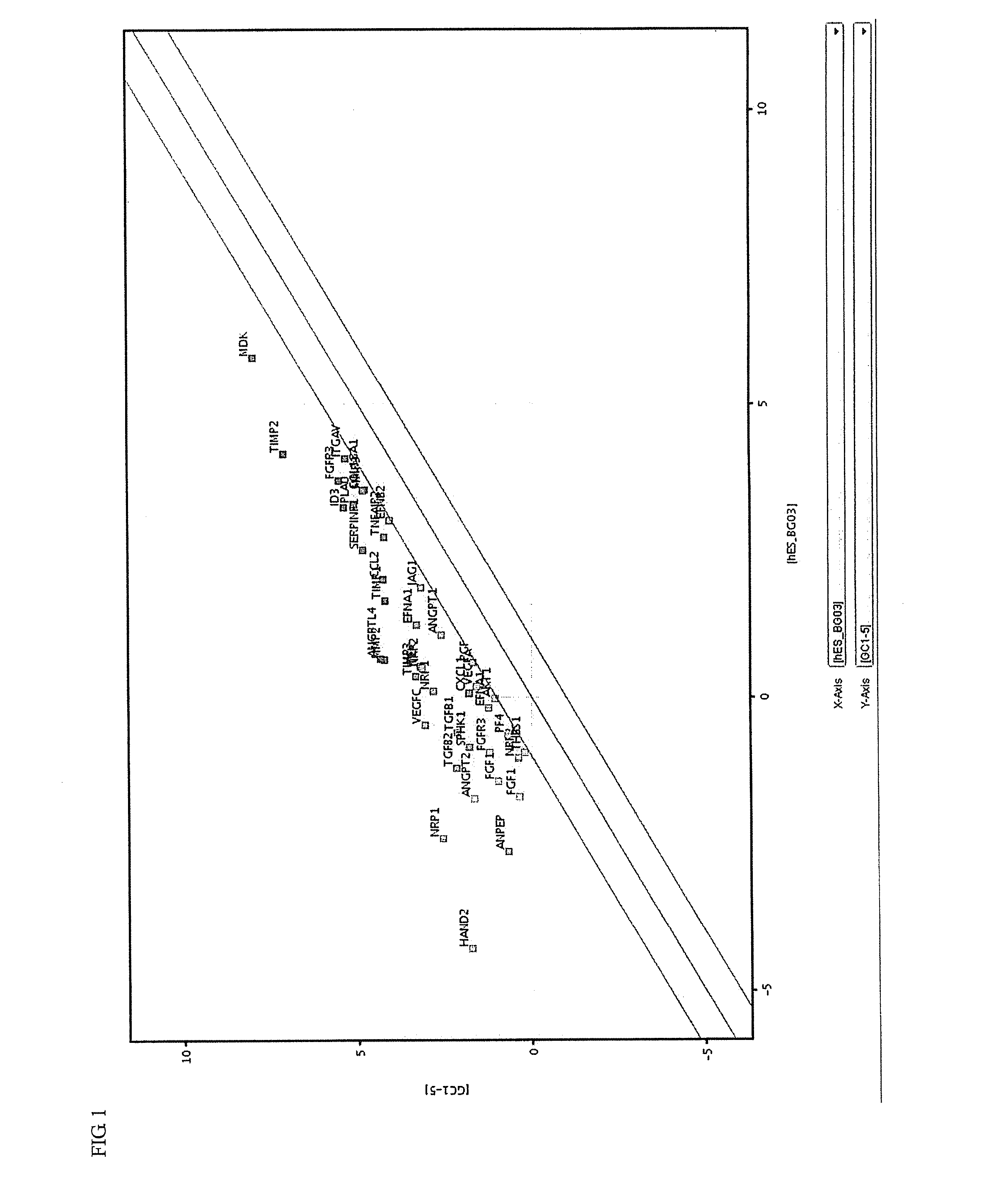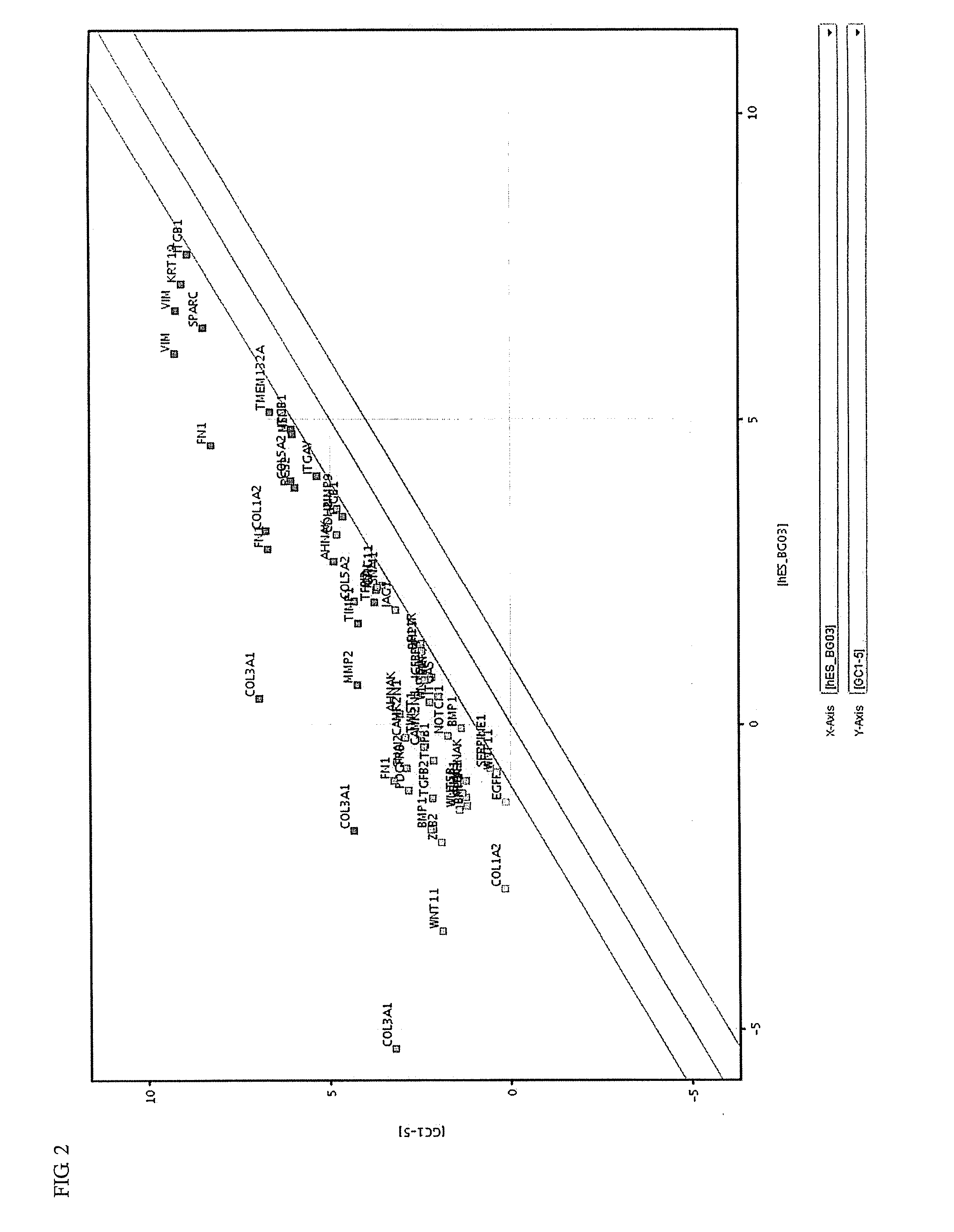Induced malignant stem cells or pre-induction cancer stem cells capable of selfreplication outside of an organism, production method for same, and practical application for same
a technology of pre-induction cancer stem cells and malignant cells, which is applied in the direction of cell culture active agents, drug compositions, tissue culture, etc., can solve the problems of difficult retention of carcinogenesis in vivo, precancerous cells or cancer cells are berrations, and none of these cell lines have been established by culture that permits self-renewal, etc., to achieve the effect of increasing expression and increasing expression of endogenous cancer-related genes
- Summary
- Abstract
- Description
- Claims
- Application Information
AI Technical Summary
Benefits of technology
Problems solved by technology
Method used
Image
Examples
example 1
Preparation of Retroviral Vectors
[0211]Three retroviral vector plasmids for the three genes, POU5F1-pMXs, KLF4-pMXs, and SOX2-pMXs, were introduced into packaging cells for preparing a pantropic retroviral vector, namely Plat-GP cells, using Fugene HD (Roche; Cat No. 4709691) to thereby prepare a retroviral vector solution. The gene vector plasmids POU5F1-pMXs, KLF4-pMXs, and SOX2-pMXs were used at a ratio of 4:2:1 in that order so as to enture that the relation of POU5F1>SOX2 was achieved. The details of the procedure are as described below.
[0212]
[0213]The vectors POU5F1-pMXs, KLF4-pMXs, and SOX2-pMXs were constructed vectors (Table 33 below).
[0214]The amounts of the respective vectors were as follows: 5 μg of POU5F1-pMXs, 2.5 μg of KLF4-pMXs, 1.25 μg of SOX2-pMXs, 1.25 μg of Venus-pCS2, 5 μg of VSV-G-pCMV, 1.25 μg of GFP-pMXs (Cell Biolab), and 45 μL of FuGENE HD.
[0215]
[0216]The vectors POU5F1-pMXs, KLF4-pMXs, and SOX2-pMXs were constructed vectors (Table 33 below).
[0217]The amoun...
example 2
Preparation of Induced Malignant Stem Cells from Cells Derived from Cancer Tissues of a Stomach Cancer Patient
[0222]Somatic cells were isolated from fresh cancer tissues of a patient with (progressive) stomach cancer, which had been stored for several hours and transported in a preservation solution. To the resultant cells derived from the cancer tissues of the stomach cancer patient, the retroviral vector solution containing the three retroviral vectors of the three genes (POU5F1, KLF4, and SOX2 at a ratio of 4:2:1 in that order), which had been prepared in Example 1 so as to ensure that the relation of POU5F1>KLF4>SOX2 was achieved, was added for gene transfer, whereby human induced malignant stem cells were prepared. The details of the procedure are as described below.
[0223]Part of fresh stomach cancer tissues obtained during operation (from a 67-year-old Japanese male patient with progressive cancer) was washed with Hank's balanced salt solution (Phenol Red-free) (Invitrogen; Ca...
example 3
Preparation of Human Induced Malignant Stem Cells from Cells Derived from Non-Cancer Tissues of a Stomach Cancer Patient
[0275]Cells were isolated from fresh non-cancer tissues of a patient with (progressive) stomach cancer, which had been stored for several hours and transported in a preservation solution, and were subjected to primary culture. To the resultant cells derived from the non-cancer tissues of the stomach cancer patient, the retroviral vector solution containing the three retroviral vectors of the three genes (POU5F1, KLF4, and SOX2 at a ratio of 4:2:1 in that order), which had been prepared in Example 1, was added for gene transfer, whereby human induced malignant stem cells were prepared. The details of the procedure are as described below.
[0276]Part of fresh non-cancer tissues obtained during operation (from a 67-year-old Japanese male patient with progressive stomach cancer) was washed with Hank's balanced salt solution (Phenol Red-free) and minced with scissors into...
PUM
 Login to View More
Login to View More Abstract
Description
Claims
Application Information
 Login to View More
Login to View More - R&D
- Intellectual Property
- Life Sciences
- Materials
- Tech Scout
- Unparalleled Data Quality
- Higher Quality Content
- 60% Fewer Hallucinations
Browse by: Latest US Patents, China's latest patents, Technical Efficacy Thesaurus, Application Domain, Technology Topic, Popular Technical Reports.
© 2025 PatSnap. All rights reserved.Legal|Privacy policy|Modern Slavery Act Transparency Statement|Sitemap|About US| Contact US: help@patsnap.com



